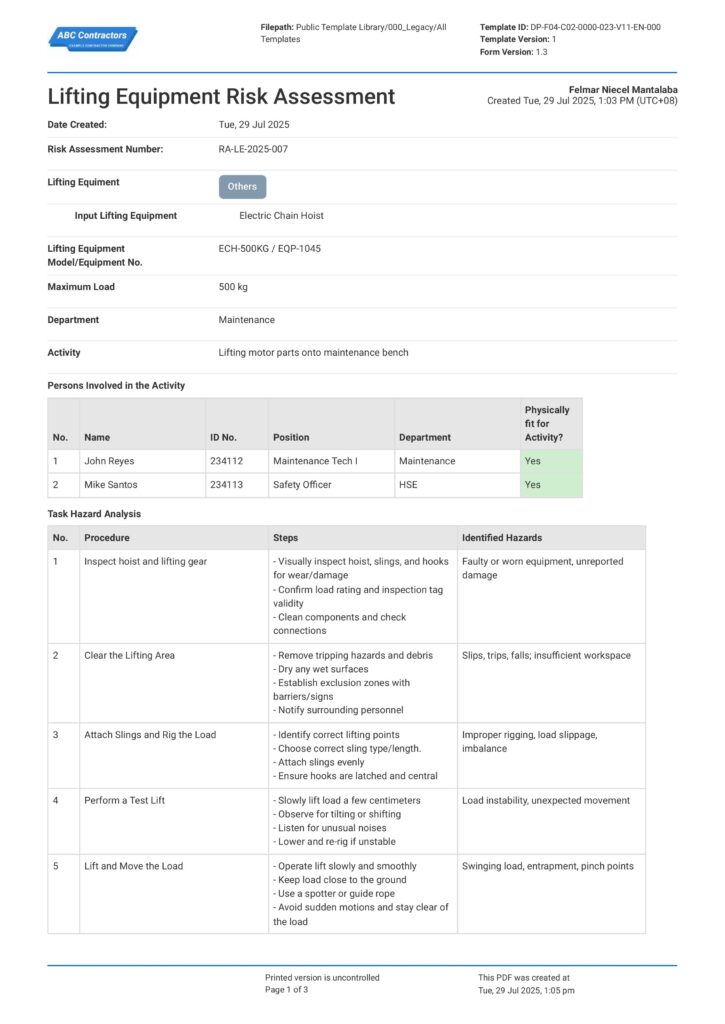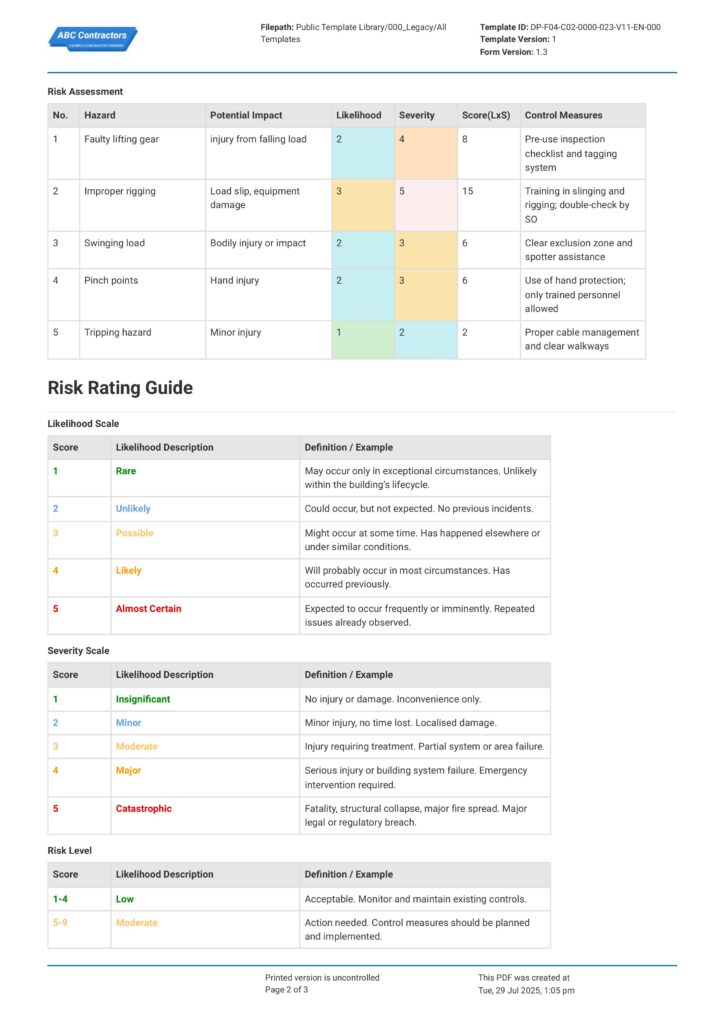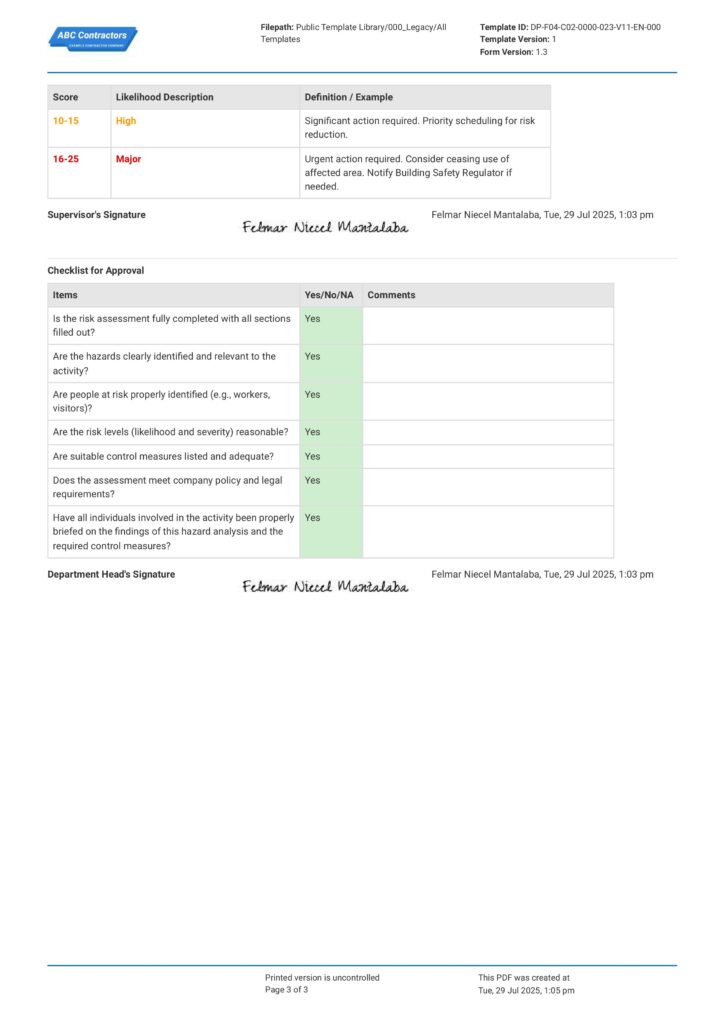Risk Assessment for Lifting Operation Template
Start with a free 30-day trial. No credit card required.
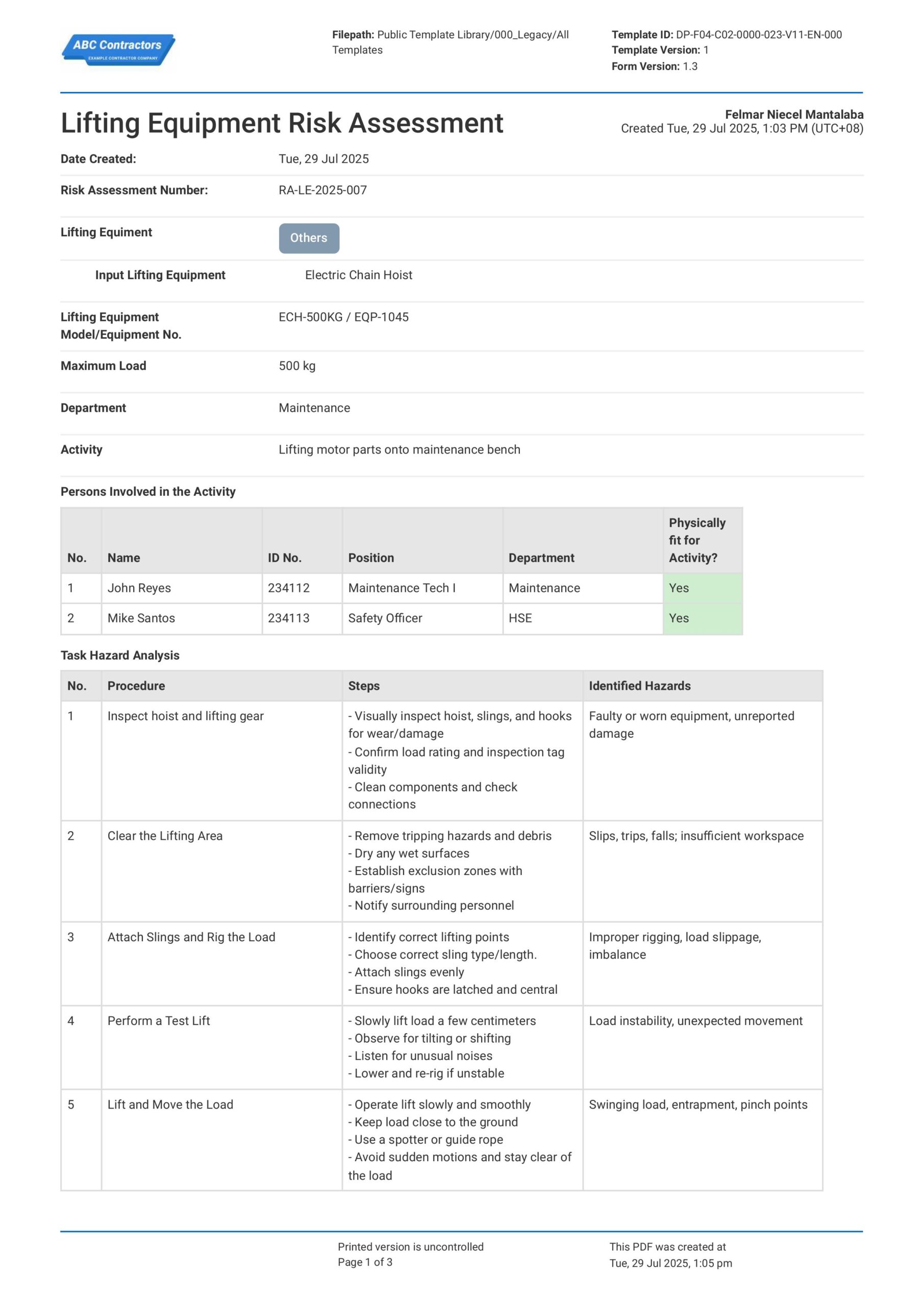
~10,000 employees
~500 employees
~25,000 employees
~20 employees
~50 employees
~1,500 employees
~20 employees
What is a Risk assessment for Lifting Operation?
A risk assessment for lifting equipment is a document outlining the risk evaluation procedure for a lifting operation, including the list of potential hazards, their respective risk assessment scores, and the controls to mitigate them. It assists operators and safety officers in detecting the possible dangers in using lifting equipment using a task hazard analysis. Operators, site officers, and site managers are able to effectively provide suitable controls and informed decisions for the hazards based on the risk scores obtained from the assessment.
A lifting equipment evaluation using a risk assessment is undertaken to decrease the possibility of injury inflicted on the site workers or any property damages during lifting operations.
Compare this Risk Assessment Lifting Equipment to paper-based forms created from Word, Excel, or PDF
Use this Risk Assessment for Lifting Operation template for free.
Lifting equipment procedure: The safe way
Lifting might sound like a simple activity, however, neglecting safety in an industrial setting can lead to numerous issues. To help prevent injury and property damage, here is a general safety procedure for lifting activities.
These are the general standard procedures that you could follow before conducting the lifting activity:
Inspect your lifting equipment prior to starting any activities
Lifting equipment must be inspected before conducting the activity. Inspections ensure that the equipment is functional, reliable, and safe during activity. Any found defects and problems should be addressed first, since they might compromise the safety and progress of the activity.
Assess the risk by using a risk assessment for lifting operation or equipment
After completing the inspection, the risk assessment can proceed. All the procedures of the lifting activity are reviewed for possible hazards and then provided with the appropriate control measures. In this procedure, a collaboration of multiple minds is necessary to provide the best control measures and safest procedures.
Plan and put in place the controls set from the lifting operation risk assessment
Now that the risk assessment has provided all the control measures, the team can begin planning the activity. Planning involves preparing the equipment and materials needed, which includes the control measures. The team also prepares the timeline of the activity and the procedure to follow, which already incorporates the control measures.
These general safety procedures should be incorporated into your operational procedures for the activity to ensure a smoother and safer execution:
Clear and keep areas clean
Clear any obstructions, including equipment and personnel, from areas where lifting, lowering, and transferring loads occur. This is to avoid any striking injuries and damage to property or assets.
Assess the load and the crane
Before rigging the load to the crane, it is wise to assess the load and the crane first. Studying the structure of the load can supply an idea of how to balance it during lifting.
Rigging
Rigging is a critical part of lifting. Improper rigging can cause imbalances, which may lead to serious problems such as property damage and severe injuries. It is best to employ trained and certified personnel to conduct the rigging process, for they have acquired the knowledge and skills of safe standard rigging procedures.
Control and monitor load movement
When loads are lifted, lowered, or transferred, personnel involved in the activity must consistently stay vigilant for any load shifts or imbalances. If any of these arise, it is best to immediately correct it for better control of the load.
These are the general standard procedures that you could follow after conducting the lifting activity:
Housekeeping should be implemented after any lifting activity
Cleaning up after the activity guarantees the cleanliness of working areas and the excellent condition of all equipment. This also avoids any unnecessary problems for any activity that comes after the lifting activity.
Review procedures and gaps overlooked during the lifting operation risk assessment
Reviewing the activity is essential for identifying gaps. These encompass procedures, control measures, or any hazards that escaped detection during the risk assessment. This process will help further improve flow and safety in any lifting activity.
Lifting equipment risk assessment example
Identifying hazards and their risks when operating lifting equipment through a risk assessment would provide the appropriate controls to effectively manage them. To give you a picture of how this should look, below is a risk assessment example flow and procedure for lifting equipment in a procedural method, which can be incorporated into the lifting equipment risk assessment document.
Choose the correct people
First, identify those who are involved. This phase gives supervisors an outlook on who is running and supporting the equipment. During this step, supervisors must also assign competent personnel to conduct the activity. Such an approach helps avoid mishandling and inexperienced staff mishaps.
Pinpoint the hazards
The next step in the procedure is to conduct a task hazard analysis. In this step, all personnel involved in the activity must collaborate to review each procedure and identify any possible hazards. This approach guarantees the identification of every hazard and equips the subsequent step with the necessary controls.
Risk Scoring
After identifying all the hazards in the task hazard analysis, a risk assessment must then be conducted. Each identified hazard is scored based on its severity and likelihood. The risk score is calculated by multiplying these two factors, which will determine the controls. Control measures can be derived from the hierarchy of controls. This method aims to select the most effective way to control hazards by following this hierarchy: elimination, substitution, engineering controls, administrative controls, and personal protective equipment.
Review
Before implementing the controls, a review must be done first. Personnel of a higher position should ensure that all hazards in a certain activity are accounted for and each of them has a satisfactory control measure. This step guarantees the safe execution of the activity and its smooth progression as planned, free from any delays caused by safety concerns.
OSHA lifting equipment requirements
Operating lifting equipment carries inherent risks. It contains numerous hazards that can seriously injure or potentially take a life. Given the dangers associated with lifting equipment, the Occupational Safety and Health Administration (OSHA) has established provisions for its use. They even provided specific requirements and regulations for both the general industry and the construction industry.
General Industry (29 CFR 1910)
The following are the provisions of the requirements and regulations for lifting equipment in the general industry
- 1910.184: Slings - This contains the requirements of ropes, metal mesh, and synthetic slings for their proper usage, inspection, and maintenance.
- 1910.179: Overhead Cranes - This details the strict specifications of the design, inspection, and up until the operation of cranes.
- 1910.179-180: Hoists - This lays out the guidelines for hoist equipment, the inspection process, and the load capacity limits.
- 1910.178: Powered Industrial Trucks (Forklift) - This covers the regulations for operating and maintaining forklifts, and the training requirements for forklift operators.
Construction Industry (29 CFR 1926)
The following are the provisions of the requirements and regulations for lifting equipment in the construction industry
- 1926.251: Rigging Equipment - This provides the requirements for rigging equipment, the proper inspection procedure, the appropriate working loads, and their maintenance.
- 1926.1400-1442: Cranes and Derricks - This includes the requirements for setting up and operating the crane, the inspection process, and for operator certification.
- 1926.552: Material Hoists and Personnel Hoists - This details the design, installation, operation, and proper inspection for hoists.
- 1926.753(d): Safety around suspended loads - This lays out the requirements and procedure on how to protect operators and site workers from suspended load hazards.
Frequently Asked Questions
Why use this Risk Assessment for Lifting Equipment template?
Sitemate's Risk Assessment for Lifting Equipment template is a smart choice because it’s already trusted by thousands of companies in construction, logistics, and heavy industry. It’s built around proven best practices for identifying and managing lifting-related hazards—so you don’t have to start from scratch. Whether you're a site manager or frontline worker, the template is designed to be simple, clear, and fast to use, making it easier to stay compliant and safe on the job.
Is this template compliant with OSHA standards?
Yes, this template can be tailored to meet OSHA requirements and is flexible enough to align with international standards like ISO 45001. It’s already being used by certified contractors in construction, manufacturing, and logistics to help ensure compliance and support ongoing certification efforts. Whether you're working under U.S. regulations or a broader safety framework, the template makes it easier to stay aligned and audit-ready.
Can I edit this Risk Assessment for Lifting Equipment for my project or company?
Yes – the template is fully customizable with intuitive drag-and-drop functionality. You can design countless document layouts using a wide range of field types such as tables, formulas, sketches, photos, and more, to suit any kind of data capture. You can also add your company logo, custom headers, and other key formatting elements. All of this is made possible through Dashpivot’s powerful template builder.
What formats is this risk assessment available in?
This template works seamlessly across all devices—computer, mobile, and tablet—so you can edit and complete forms in the office or directly from the field. Whether you're handling [insert use case] tasks on-site or at your desk, it's easy to stay on top of documentation. Once completed, records can be generated or exported as PDF or CSV files, giving you the flexibility of Word, Excel, and PDF formats with the added efficiency of modern software.
Other popular templates you can use and edit for free
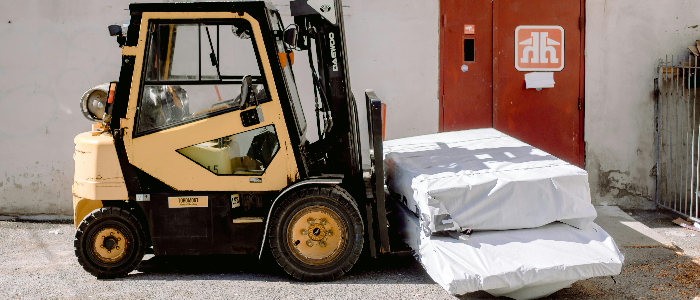
Complete and structure your risk assessment for forklifts more efficiently.

Risk Assessment for Excavations
Use this excavation risk assessment template to ensure you don't have any catastrophic excavation incidents.

Lone Working Risk Assessment template
Ensure lone workers and their companies know the hazards, controls, and precautions.
This risk assessment was generated with Dashpivot
Identify and remove possible dangers before they cause serious harm. This risk assessment for lifting equipment includes tables that enable you to input various processes and associated risks while completing the assessment. This form assists you in conducting a comprehensive risk assessment that complies with requirements while also protecting your personnel and assets.
- Complete, edit, and review the risk assessment for lifting equipment from any device.
- Export and send assessments as perfectly formatted PDF documents with your company logo.
- Securely store and manage your report assessments for easy searching and finding.
- Directly notify managers for review and sign-off after completing the assessment.
Sitemate builds best-in-class software tools for built world companies.
